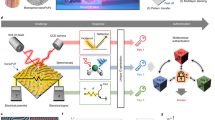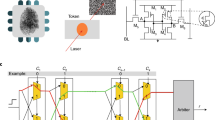Abstract
Physically unclonable functions (PUFs) are a promising technology for generating cryptographic primitives using random imperfections in a physical entity. However, the keys inside PUFs are still vulnerable as they must be written into non-volatile memories and shared with participants that do not hold the PUF before secure communication. Here we show that pairs of identical PUFs (twin PUFs) can be fabricated together on an aligned carbon nanotube array and used for secure communication without key pre-extraction and storage. Two rows of field-effect transistors are fabricated perpendicular to the carbon nanotube growth direction, randomly producing three types of transistor channel—based on metallic nanotubes, semiconducting nanotubes and no nanotubes—that can be used to extract ternary bits for use as a shared key. The twin PUFs exhibit high uniformity, uniqueness, randomness and reliability, as well as a consistency of approximately 95%. We show that separated twin PUFs can provide secure communication with a bit error rate of one bit per trillion via a fault-tolerant design.
This is a preview of subscription content, access via your institution
Access options
Access Nature and 54 other Nature Portfolio journals
Get Nature+, our best-value online-access subscription
$29.99 / 30 days
cancel any time
Subscribe to this journal
Receive 12 digital issues and online access to articles
$119.00 per year
only $9.92 per issue
Buy this article
- Purchase on Springer Link
- Instant access to full article PDF
Prices may be subject to local taxes which are calculated during checkout




Similar content being viewed by others
Data availability
The data that support the findings of this study are available from the corresponding authors upon reasonable request.
References
Goldreich, O. Foundations of Cryptography: Basic Tools (Cambridge Univ. Press, 2001).
Rivest, R., Shamir, A. & Adleman, L. A method for obtaining digital signatures and public-key cryptosystems. Commun. ACM 21, 120–126 (1978).
Thorsteinson, P. & Ganesh, G. G. A. NET Security and Cryptography (Prentice Hall Professional, 2004).
Shor, P. W. Polynomial-time algorithms for prime factorization and discrete logarithms on a quantum computer. SIAM J. Comput. 26, 1484–1509 (1997).
Sadeghi, A. R. & Naccache, D. Towards Hardware-Intrinsic Security: Foundations and Practice (Springer, 2010).
Kömmerling, O. & Kuhn, M. G. Design principles for tamper-resistant smartcard processors. Smartcard 99, 9–20 (1999).
Shor, P. W. & Preskill, J. Simple proof of security of the BB84 quantum key distribution protocol. Phys. Rev. Lett. 85, 441–444 (2000).
Scarani, V. et al. The security of practical quantum key distribution. Rev. Mod. Phys. 81, 1301–1350 (2009).
Beveratos, A. et al. Single photon quantum cryptography. Phys. Rev. Lett. 89, 187901 (2002).
Aspelmeyer, M., Jennewein, T., Pfennigbauer, M., Leeb, W. R. & Zeilinger, A. Long-distance quantum communication with entangled photons using satellites. IEEE J. Sel. Topics Quantum Electron. 9, 1541–1551 (2003).
Pappu, R., Recht, B., Taylor, J. & Gershenfeld, N. Physical one-way functions. Science 297, 2026–2030 (2002).
Herder, C., Yu, M.-D., Koushanfar, F. & Devadas, S. Physical unclonable functions and applications: a tutorial. Proc. IEEE 102, 1126–1141 (2014).
Roel, M. Physically Unclonable Functions: Constructions, Properties and Applications. PhD thesis, Univ. KU Leuven (2012).
Kang, H., Hori, Y., Katashita, T., Hagiwara, M. & Iwamura, K. Cryptographic key generation from PUF data using efficient fuzzy extractors. In 16th International Conference on Advanced Communication Technology 23–26 (IEEE, 2014).
Maes, R., Van Herrewege, A. & Verbauwhede, I. PUFKY: a fully functional PUF-based cryptographic key generator. In International Workshop on Cryptographic Hardware and Embedded Systems 302–319 (Springer, 2012).
Rührmair, U. & Holcomb, D. E. PUFs at a glance. In 2014 Design, Automation & Test in Europe Conference & Exhibition (DATE) 1–6 (IEEE, 2014).
Gassend, B., Clarke, D., van Dijk, M. & Devadas, S. Silicon physical random functions. In Proc. 9th ACM Conference on Computer and Communications Security (ed. Atluri, V.) 148–160 (ACM Press, 2002).
Bolotnyy, L. & Robins, G. Physically unclonable function-based security and privacy in RFID systems. In Fifth Annual IEEE International Conference on Pervasive Computing and Communications (PerCom’07) 211–220 (IEEE, 2007).
Guajardo, J., Kumar, S. S., Schrijen, G.-J. & Tuyls, P. FPGA intrinsic PUFs and their use for IP protection. In Cryptographic Hardware and Embedded Systems—CHES 2007 (eds. Paillier, P. & Verbauwhede, I.) 63–80 (Springer, 2007).
Rahman, F., Shakya, B., Xu, X. L., Forte, D. & Tehranipoor, M. Security beyond CMOS: fundamentals, applications, and roadmap. IEEE Trans. Very Large Scale Integr. (VLSI) Syst. 25, 3420–3433 (2017).
Waser, R., Dittmann, R., Staikov, G. & Szot, K. Redox-based resistive switching memories—nanoionic mechanisms, prospects, and challenges. Adv. Mater. 21, 2632–2663 (2009).
Chen, A. Comprehensive assessment of RRAM-based PUF for hardware security applications. In Proc. 2015 IEEE International Electron Devices Meeting (IEDM) 10.7.1–10.7.4 (IEEE, 2015).
Liu, R., Wu, H. Q., Pang, Y. C., Qian, H. & Yu, S. M. Experimental characterization of physical unclonable function based on 1 kb resistive random access memory arrays. IEEE Electron Device Lett. 36, 1380–1383 (2015).
Nili, H. et al. Hardware-intrinsic security primitives enabled by analogue state and nonlinear conductance variations in integrated memristors. Nat. Electron. 1, 197–202 (2018).
Hu, Z. Y. & Han, S.-J. Creating security primitive by nanoscale nanipulation of carbon nanotubes. In 2017 IEEE International Symposium on Hardware Oriented Security and Trust (HOST) 29–34 (IEEE, 2017).
Hu, Z. et al. Physically unclonable cryptographic primitives using self-assembled carbon nanotubes. Nat. Nanotech. 11, 559–565 (2016).
Dodda, A. et al. Graphene-based physically unclonable functions that are reconfigurable and resilient to machine learning attacks. Nat. Electron. 4, 364–374 (2021).
Alharbi, A., Armstrong, D., Alharbi, S. & Shahrjerdi, D. Physically unclonable cryptographic primitives by chemical vapor deposition of layered MoS2. ACS Nano 11, 12772–12779 (2017).
He, Z. et al. Design of delayed ternary PUF circuit based on CNFET. In 2018 24th Asia-Pacific Conference on Communications (APCC) 503–507 (IEEE, 2018).
Huang, M. G., Yu, B. & Li, S. S. PUF-assisted group key distribution scheme for software-defined wireless sensor networks. IEEE Commun. Lett. 22, 404–407 (2018).
Delavar, M., Mirzakuchaki, S., Ameri, M. H. & Mohajeri, J. PUF based solutions for secure communications in advanced metering infrastructure AMI. Int. J. Commun. Syst. 67, 74–88 (2017).
Chatterjee, U., Chakraborty, R. S. & Mukhopadhyay, D. A PUF-based secure communication protocol for IoT. ACM Trans. Embedded Comput. Syst. 16, 67 (2017).
Liu, L. et al. Aligned, high-density semiconducting carbon nanotube arrays for high-performance electronics. Science 368, 850–856 (2020).
Shi, H. et al. Radiofrequency transistors based on aligned carbon nanotube arrays. Nat. Electron. 4, 405–415 (2021).
Zhao, C. et al. Strengthened complementary metal–oxide–semiconductor logic for small-band-gap semiconductor-based high-performance and low-power application. ACS Nano 14, 15267–15275 (2020).
Bishop, M. D. et al. Fabrication of carbon nanotube field-effect transistors in commercial silicon manufacturing facilities. Nat. Electron. 3, 492–501 (2020).
Hills, G. et al. Modern microprocessor built from complementary carbon nanotube transistors. Nature 572, 595–602 (2019).
Shulaker, M. M. et al. Three-dimensional integration of nanotechnologies for computing and data storage on a single chip. Nature 547, 74–78 (2017).
Si, J. et al. Scalable preparation of high-density semiconducting carbon nanotube arrays for high-performance field-effect transistors. ACS Nano 12, 627–634 (2018).
Kang, S. J. et al. High-performance electronics using dense, perfectly aligned arrays of single-walled carbon nanotubes. Nat. Nanotechnol. 2, 230–236 (2007).
Zhang, J., Patil, N., Hazeghi, A. & Mitra, S. Carbon nanotube circuits in the presence of carbon nanotube density variations. In Proc. 46th Annual Design Automation Conference 71–76 (ACM, 2009).
Franklin, A. D. The road to carbon nanotube transistors. Nature 498, 443–444 (2013).
Xiao, J. L. et al. Alignment controlled growth of single-walled carbon nanotubes on quartz substrates. Nano Lett. 9, 4311–4319 (2009).
Kocabas, C., Kang, S. J., Ozel, T., Shim, M. & Rogers, J. A. Improved synthesis of aligned arrays of single-walled carbon nanotubes and their implementation in thin film type transistors. J. Phys. Chem. C 111, 17879–17886 (2007).
Zhong, D. et al. Solution-processed carbon nanotubes based transistors with current density of 1.7 mA/μm and peak transconductance of 0.8 mS/μm. In Proc. 2017 IEEE International Electron Devices Meeting (IEDM) 5.6.1–5.6.4 (IEEE, 2017).
Xie, X. et al. Microwave purification of large-area horizontally aligned arrays of single-walled carbon nanotubes. Nat. Commun. 5, 5332 (2014).
Shah, K. A. & Tali, B. A. Synthesis of carbon nanotubes by catalytic chemical vapour deposition: a review on carbon sources, catalysts and substrates. Mater. Sci. Semicond. Process 41, 67–82 (2016).
Wang, J. T. et al. Growing highly pure semiconducting carbon nanotubes by electrotwisting the helicity. Nat. Catal. 1, 326–331 (2018).
Maiti, A. Gunreddy, V. & Schaumont P. A systematic method to evaluate and compare the performance of physical unclonable functions. In Embedded Systems Design with FPGAs 245–267 (Springer, 2013).
Gao, Y., Ranasinghe, D. C., Al-Sarawi, S. F., Kavehei, O. & Abbott, D. Memristive crypto primitive for building highly secure physical unclonable functions. Sci. Rep. 5, 12785 (2015).
Rukhin, A. et al. A Statistical Test Suite for Random and Pseudorandom Number Generators for Cryptographic Applications. Report No. 800-22 (NIST, 2001).
Dresselhaus, G., Dresselhaus, M. S. & Saito, R. Physical Properties of Carbon Nanotubes (Imperial College Press, 1998).
Xie, Y. et al. Highly temperature-stable carbon nanotube transistors and gigahertz integrated circuits for cryogenic electronics. Adv. Electron. Mater. 7, 2100202 (2021).
Westermana, R. J. et al. Plasma dicing: current state & future trends. ECS Trans. 69, 3–14 (2015).
Acknowledgements
This work was supported by the National Key Research & Development Program (grant no. 2021YFA1202904); the Beijing Municipal Science and Technology Commission (grant no. Z191100007019001-3); the Basic and Applied Basic Research Major Programme of Guangdong Province, China (grant no. 2021B0301030003); and Jihua Laboratory (project no. X210141TL210).
Author information
Authors and Affiliations
Contributions
Z.Z. and L.-M.P. proposed and supervised the project. D.Z., Z.Z. and L.-M.P. conceived the idea of twin PUFs and designed the experiment. D.Z. fabricated the devices. D.Z., J.L., Y.X., H.S. and C.Z. performed the electrical measurements. D.Z. performed the modelling and simulations. M.X. grew and characterized the aligned CNT arrays. J.L., L.J. and L.D. performed the NIST statistical randomness test. D.Z., Z.Z. and L.-M.P. analysed the data and co-wrote the manuscript. All the authors discussed the results and commented on the manuscript.
Corresponding authors
Ethics declarations
Competing interests
The authors declare no competing interests.
Peer review
Peer review information
Nature Electronics thanks Miguel Garcia-Bosque, Jin-Woo Han and Satish Kumar for their contribution to the peer review of this work.
Additional information
Publisher’s note Springer Nature remains neutral with regard to jurisdictional claims in published maps and institutional affiliations.
Supplementary information
Supplementary Information
Supplementary Figs. 1–21 and Table 1.
Rights and permissions
About this article
Cite this article
Zhong, D., Liu, J., Xiao, M. et al. Twin physically unclonable functions based on aligned carbon nanotube arrays. Nat Electron 5, 424–432 (2022). https://doi.org/10.1038/s41928-022-00787-x
Received:
Accepted:
Published:
Issue Date:
DOI: https://doi.org/10.1038/s41928-022-00787-x
This article is cited by
-
All-silicon multidimensionally-encoded optical physical unclonable functions for integrated circuit anti-counterfeiting
Nature Communications (2024)
-
Printed smart devices for anti-counterfeiting allowing precise identification with household equipment
Nature Communications (2024)
-
Random fractal-enabled physical unclonable functions with dynamic AI authentication
Nature Communications (2023)
-
2D carbon network arranged into high-order 3D nanotube arrays on a flexible microelectrode: integration into electrochemical microbiosensor devices for cancer detection
NPG Asia Materials (2023)
-
Security keys from paired up nanotube devices
Nature Electronics (2022)



